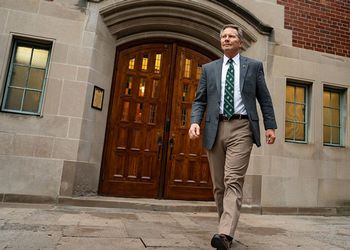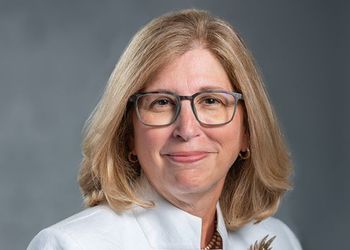Room to learn: Spartans invest in Uganda's future

In the shadow of southwest Uganda’s Rwenzori Mountains—where Dian Fossey’s Gorillas in the Mist was filmed—thick rainforests, wetlands and savannahs create a quilt of national parks and nature preserves. It’s the Africa most familiar to Americans. Elephants, monkeys, chimpanzees, baboons, antelope and bush pigs roam freely. African grey parrots, hornbills, majestic great blue turacos and hundreds of other bird species create the soundscape.
But the draw for some is the area’s most elusive resident—a tiny bird known as Shelley’s crimsonwing finch. Only two verified photographs of the finches are known to exist. One was taken by Benson Bamatura, a friendly, diminutive area field guide with a Colgate smile. He’d often embark well before sunrise to set nets in a global quest to study and release the red- and olive-colored birds, which scientists believe are on the brink of extinction.
If anyone could spot the species, it was Bamatura, who lived in nearby Bigodi village. He recognized more than 700 bird species and 300 birdcalls, wrote Eelco Meyjes, a director of the South Africa-based Rare Finch Conservation Group (RFCG), in an email. Bamatura conducted research and led eco-tours for the group.
Some Michigan State University students were lucky enough to meet Bamatura on study-abroad programs over the years. In 2013, alumna Sarah Scott was among them. She was in Uganda taking the MSU course Apes to Aves: The Evolution of Forest Biodiversity in neighboring Kibale National Park. Bamatura had collaborated with MSU faculty to help guide a study abroad experience in Uganda and was known equally for his passion for wildlife conservation, his big heart and his friendly personality.
Uganda is a biodiversity hotspot containing habitats ranging from savannahs to snow-capped peaks and mountain forests to dense, lower-altitude rainforests, Scott said.
“Bigodi … is in a key geographical and environmental position,” she said, noting that ecotourism revenue from guided tours of the Bigodi Wetland Sanctuary helps support the village and its secondary school.
Tragically, the world lost Bamatura in January 2014. He died after a prolonged illness; he was just 33 and left behind his wife and five children, along with a legion of local and international friends.
News of his death rippled across MSU’s campus, and a group of students brainstormed about how they could honor Bamatura while also helping his wife and children.
They settled on education assistance for the Bamatura children. That’s when the village school board agreed to waive the children’s secondary school fees (grades 8-13)—if it had a new classroom. The proposal would lift an enormous financial burden from Mrs. Bamatura. Ugandans on average make about $500 a year. But it costs $100 annually to send a child to school.
Villagers understand the importance of their children’s education. Some 350 students a year were crammed into Bigodi’s five small classrooms. The secondary school teaches a conservation-based curriculum, focusing in-depth lessons on the value of environmental preservation. Its graduates grow up to become their generation’s conservationists and trail guides in nearby national parks and reservations.
Scott loved everything about Bigodi and its schools. She decided to spearhead the effort to build the village a new classroom.
First, she recruited Kirk Mason, a fellow Spartan alumnus and her boyfriend. They consulted with U.S. contractors—who estimated the job could take at least four months and cost roughly $10,000.
Scott and Mason, both 2014 graduates, launched a crowdfunding website seeking donations. They took their story to newspapers and radio stations. And they decided to move to Bigodi until the classroom was ready to welcome students.
Their interests, expertise and skills aligned perfectly with the task at hand. Scott earned her bachelor’s in zoology in the Lyman Briggs College and Honors College, with multidisciplinary majors in ecology, evolution and organismal biology, plus a major in environmental studies from the College of Natural Science. Kirk earned his bachelor’s degree in the Residential College of Arts and Humanities with two additional specializations in documentary studies and media information from the College of Communications Arts and Sciences.
The pair immediately discovered that fundraising was an uphill climb. “There were many people who were hesitant to donate … because they thought we were too young to be responsible enough to plan and execute such a plan,” said Scott. “It was daunting to dedicate our lives to something that required moving to a different continent. But it wasn’t a difficult decision. The need arose and we had the opportunity to take action.”
As Mason said, “If I hadn’t met people at MSU with the same drive and determination to get things done in the world, I never would have been able to accomplish something like this. It’s just an attitude that Spartans have to do whatever it takes.”
Family, friends, MSU’s Center for Regional Food Systems, the RFCG and big-hearted people from all over supported the cause.
Last January the couple unpacked their bags in Bigodi. Village native Kemigisha Harriet, one of Bamatura’s fellow bird guides, put them up, fed them and signed on as project manager and translator. Fortunately, most Ugandans speak some English. And Scott and Mason picked up some conversational Rutooro, the local language.
Harriet hired the area’s best masons, welders and tradesmen, all accustomed to building with locally available products—minus the luxury of power tools.
“To us, building a school seemed impossible,” Scott said. “We’re very grateful there was such a wonderful group (of Bigodi villagers)” who got behind it.
Meanwhile, the Spartans came up with other ways through which to contribute their talents. They started a hands-on conservation club for area children; produced online videos (Ugandan Explorers) to raise awareness of western Uganda’s rich, biologically diverse environment; made a documentary on detriments to the region’s dwindling bee populations; and created a documentary highlighting the region’s local food and provisioning systems, thanks to help from the MSU Center for Regional Food Systems.
Meanwhile at the site “construction moved quickly (in the dry season) since sunny days provided perfect conditions for concrete to set. But it slowed down (masonry) work because water had to be pumped from nearby boreholes into jerry cans, which were strapped to bicycles and transported to the schoolyard,” Scott said.
By the time the rainy season arrived, the building was almost all under roof and the interior work was completed. Finishing touches included a wide green stripe painted around the foundation.
Villagers at every turn greeted the couple and expressed gratitude for the desperately needed classroom taking shape in the schoolyard.
“We wanted to make sure Bamatura’s message of conservation was recognized and carried on” through education for decades to come, the couple said.
In April, Bamatura’s family and friends, villagers and school officials met at the classroom for a dedication ceremony. Benson’s younger brother, Johnson, spoke on behalf of the Bamatura family. “He said they were very thankful and wanted to make sure we understood that our contribution to the community was greatly appreciated,” Mason said.
The couple added one final touch before departing. They unveiled a green and white plaque outside the building inscribed: “Constructed in Memory of Benson Bamatura. Sponsored by Alumni and Friends of Michigan State University, April 2015.”?



